Case Study: Information Systems Influence on TFL Customer Excellence
VerifiedAdded on 2020/04/21
|54
|12492
|105
Case Study
AI Summary
This case study investigates the role of information systems in enhancing customer excellence at Transport for London (TFL) between 2010 and 2017. The study explores the types of information systems used by TFL, including Transaction Processing Systems, Decision Support Systems, and Enterprise Resource Planning (ERP) systems, and their impact on business performance. It examines TFL's data collection and interpretation procedures, focusing on how they leverage information systems to improve customer service. The research addresses the limitations of the study, such as the secondary data collection method and lack of consideration for the economic impact of TFL. The analysis includes a thematic analysis of the data and provides recommendations for TFL to continually improve its performance through the effective use of information systems, focusing on customer needs and technological advancements, such as contactless payment systems and mobile network accessibility. The study also explores the use of Big Data and its interpretation for customer service improvements.
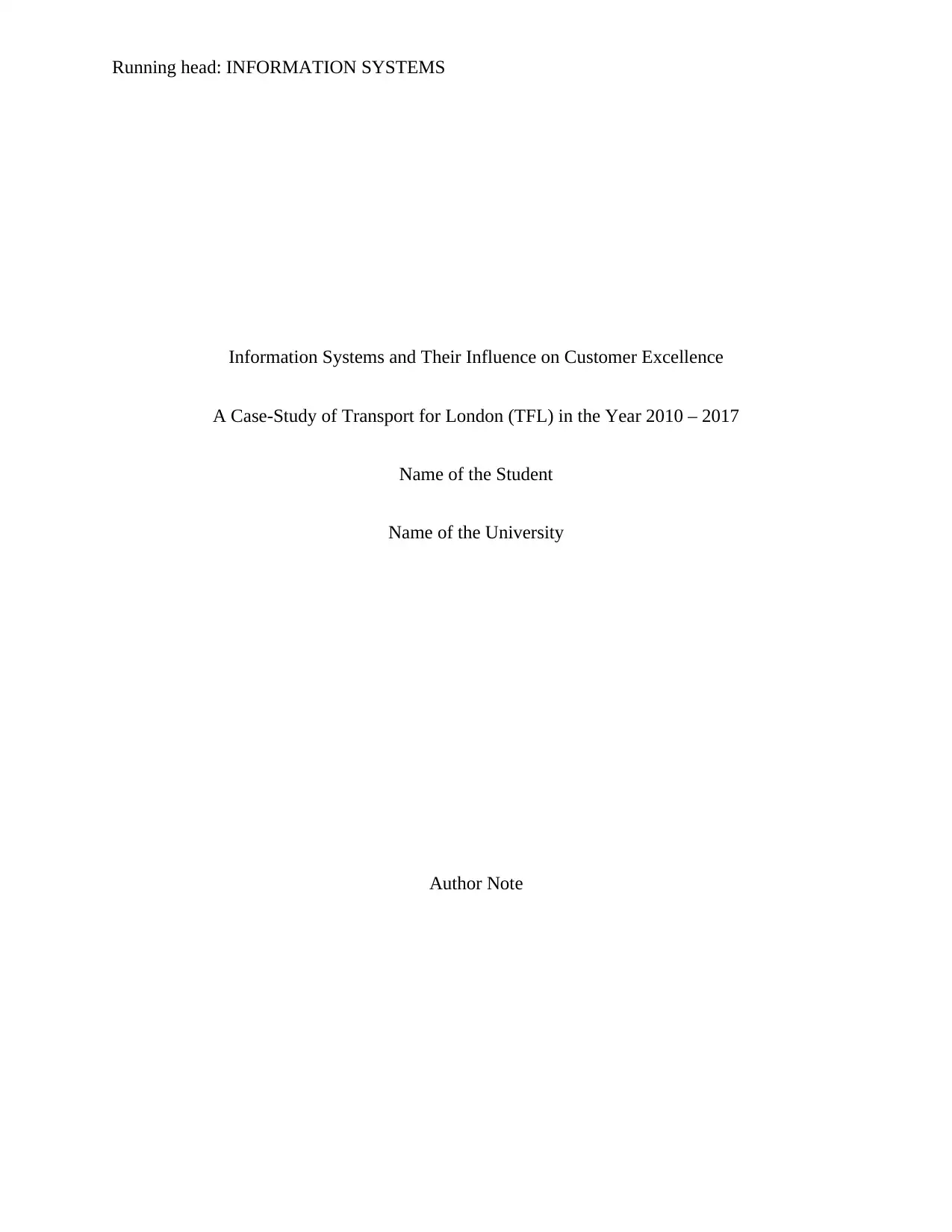
Running head: INFORMATION SYSTEMS
Information Systems and Their Influence on Customer Excellence
A Case-Study of Transport for London (TFL) in the Year 2010 – 2017
Name of the Student
Name of the University
Author Note
Information Systems and Their Influence on Customer Excellence
A Case-Study of Transport for London (TFL) in the Year 2010 – 2017
Name of the Student
Name of the University
Author Note
Paraphrase This Document
Need a fresh take? Get an instant paraphrase of this document with our AI Paraphraser

1INFORMATION SYSTEMS
Acknowledgement
I have gathered a great knowledge and experience by conducting this research. Conduction of the
research has helped me to improve my knowledge regarding employee motivation as well as
employee retention. I have gained great help from my supervisors while conducting this research
and therefore, I would like to thank my supervisor .................................... for guiding me
throughout the research. I would also like to thank my friends and family members for
supporting me in this difficult phase. I would also like to thank the participants of data collection
process as without their participation I might not be able to complete this research with best
outcome.
Thanks and regards
Yours Sincerely,
Acknowledgement
I have gathered a great knowledge and experience by conducting this research. Conduction of the
research has helped me to improve my knowledge regarding employee motivation as well as
employee retention. I have gained great help from my supervisors while conducting this research
and therefore, I would like to thank my supervisor .................................... for guiding me
throughout the research. I would also like to thank my friends and family members for
supporting me in this difficult phase. I would also like to thank the participants of data collection
process as without their participation I might not be able to complete this research with best
outcome.
Thanks and regards
Yours Sincerely,

2INFORMATION SYSTEMS
Abstract
In this research, the researcher analyses the various information systems and their
influence on achieving customer excellence. London is having one of the busiest transportation
services around the world that is used by both daily commuters and the tourists. Millions of
people use London’s underground tube services, over ground rail services, taxis and buses as the
principle modes of transportation. With such huge number of commuters availing the different
transportation services in London, Transport for London aim towards using information systems
effectively in order to achieve customer excellence. With time, Transport for London has used
various technologies for developing a better understanding about the traffic of the trains, buses
and taxis along with the tracking the movement of the commuters. It has been seen that
Transport for London has successfully made mobile network accessible and available for the
commuters by using information systems. However, Transport for London also requires some
improvements in order to use information systems more efficiently in order to achieve customer
excellence.
Abstract
In this research, the researcher analyses the various information systems and their
influence on achieving customer excellence. London is having one of the busiest transportation
services around the world that is used by both daily commuters and the tourists. Millions of
people use London’s underground tube services, over ground rail services, taxis and buses as the
principle modes of transportation. With such huge number of commuters availing the different
transportation services in London, Transport for London aim towards using information systems
effectively in order to achieve customer excellence. With time, Transport for London has used
various technologies for developing a better understanding about the traffic of the trains, buses
and taxis along with the tracking the movement of the commuters. It has been seen that
Transport for London has successfully made mobile network accessible and available for the
commuters by using information systems. However, Transport for London also requires some
improvements in order to use information systems more efficiently in order to achieve customer
excellence.
⊘ This is a preview!⊘
Do you want full access?
Subscribe today to unlock all pages.

Trusted by 1+ million students worldwide
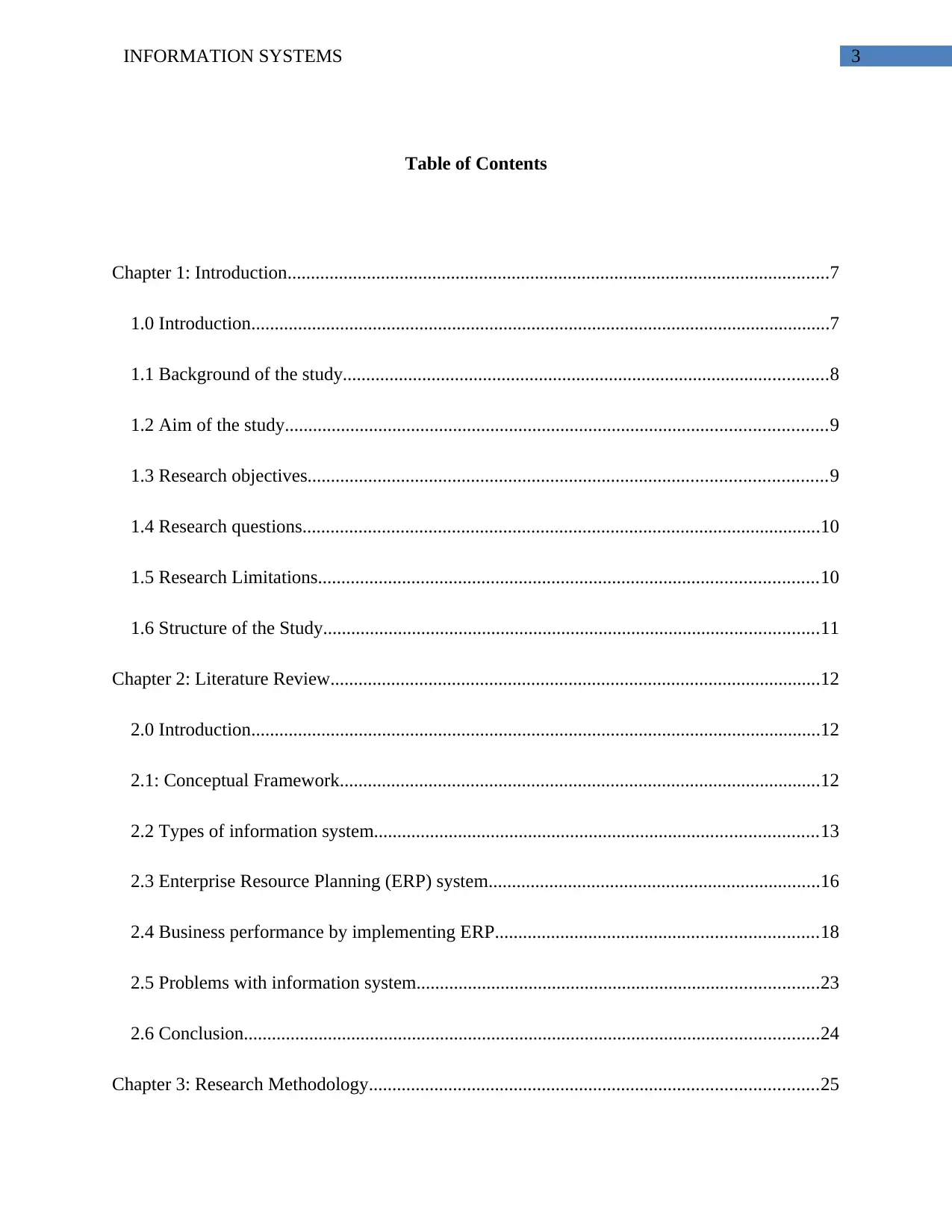
3INFORMATION SYSTEMS
Table of Contents
Chapter 1: Introduction....................................................................................................................7
1.0 Introduction............................................................................................................................7
1.1 Background of the study........................................................................................................8
1.2 Aim of the study....................................................................................................................9
1.3 Research objectives...............................................................................................................9
1.4 Research questions...............................................................................................................10
1.5 Research Limitations...........................................................................................................10
1.6 Structure of the Study..........................................................................................................11
Chapter 2: Literature Review.........................................................................................................12
2.0 Introduction..........................................................................................................................12
2.1: Conceptual Framework.......................................................................................................12
2.2 Types of information system...............................................................................................13
2.3 Enterprise Resource Planning (ERP) system.......................................................................16
2.4 Business performance by implementing ERP.....................................................................18
2.5 Problems with information system......................................................................................23
2.6 Conclusion...........................................................................................................................24
Chapter 3: Research Methodology................................................................................................25
Table of Contents
Chapter 1: Introduction....................................................................................................................7
1.0 Introduction............................................................................................................................7
1.1 Background of the study........................................................................................................8
1.2 Aim of the study....................................................................................................................9
1.3 Research objectives...............................................................................................................9
1.4 Research questions...............................................................................................................10
1.5 Research Limitations...........................................................................................................10
1.6 Structure of the Study..........................................................................................................11
Chapter 2: Literature Review.........................................................................................................12
2.0 Introduction..........................................................................................................................12
2.1: Conceptual Framework.......................................................................................................12
2.2 Types of information system...............................................................................................13
2.3 Enterprise Resource Planning (ERP) system.......................................................................16
2.4 Business performance by implementing ERP.....................................................................18
2.5 Problems with information system......................................................................................23
2.6 Conclusion...........................................................................................................................24
Chapter 3: Research Methodology................................................................................................25
Paraphrase This Document
Need a fresh take? Get an instant paraphrase of this document with our AI Paraphraser
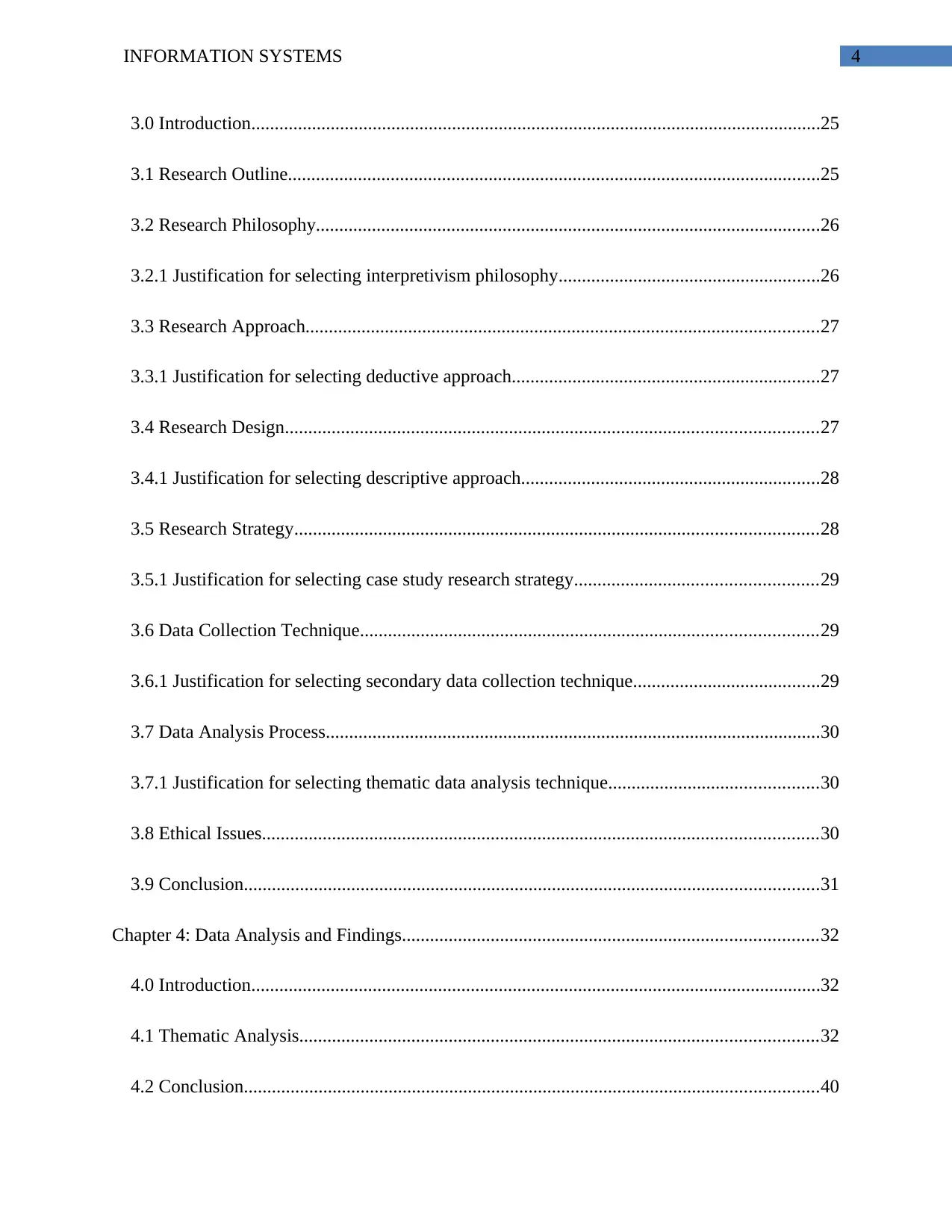
4INFORMATION SYSTEMS
3.0 Introduction..........................................................................................................................25
3.1 Research Outline..................................................................................................................25
3.2 Research Philosophy............................................................................................................26
3.2.1 Justification for selecting interpretivism philosophy........................................................26
3.3 Research Approach..............................................................................................................27
3.3.1 Justification for selecting deductive approach..................................................................27
3.4 Research Design..................................................................................................................27
3.4.1 Justification for selecting descriptive approach................................................................28
3.5 Research Strategy................................................................................................................28
3.5.1 Justification for selecting case study research strategy....................................................29
3.6 Data Collection Technique..................................................................................................29
3.6.1 Justification for selecting secondary data collection technique........................................29
3.7 Data Analysis Process..........................................................................................................30
3.7.1 Justification for selecting thematic data analysis technique.............................................30
3.8 Ethical Issues.......................................................................................................................30
3.9 Conclusion...........................................................................................................................31
Chapter 4: Data Analysis and Findings.........................................................................................32
4.0 Introduction..........................................................................................................................32
4.1 Thematic Analysis...............................................................................................................32
4.2 Conclusion...........................................................................................................................40
3.0 Introduction..........................................................................................................................25
3.1 Research Outline..................................................................................................................25
3.2 Research Philosophy............................................................................................................26
3.2.1 Justification for selecting interpretivism philosophy........................................................26
3.3 Research Approach..............................................................................................................27
3.3.1 Justification for selecting deductive approach..................................................................27
3.4 Research Design..................................................................................................................27
3.4.1 Justification for selecting descriptive approach................................................................28
3.5 Research Strategy................................................................................................................28
3.5.1 Justification for selecting case study research strategy....................................................29
3.6 Data Collection Technique..................................................................................................29
3.6.1 Justification for selecting secondary data collection technique........................................29
3.7 Data Analysis Process..........................................................................................................30
3.7.1 Justification for selecting thematic data analysis technique.............................................30
3.8 Ethical Issues.......................................................................................................................30
3.9 Conclusion...........................................................................................................................31
Chapter 4: Data Analysis and Findings.........................................................................................32
4.0 Introduction..........................................................................................................................32
4.1 Thematic Analysis...............................................................................................................32
4.2 Conclusion...........................................................................................................................40
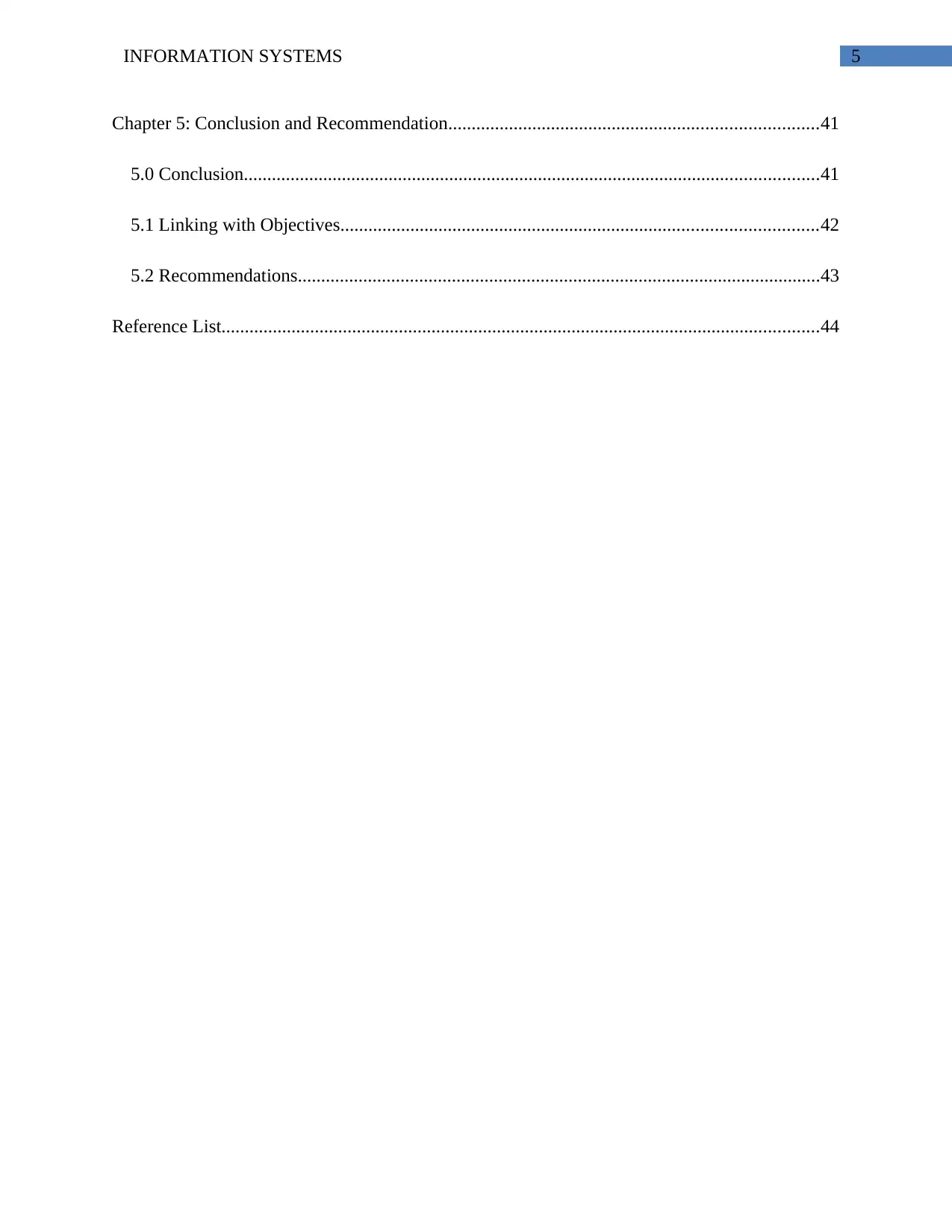
5INFORMATION SYSTEMS
Chapter 5: Conclusion and Recommendation...............................................................................41
5.0 Conclusion...........................................................................................................................41
5.1 Linking with Objectives......................................................................................................42
5.2 Recommendations................................................................................................................43
Reference List................................................................................................................................44
Chapter 5: Conclusion and Recommendation...............................................................................41
5.0 Conclusion...........................................................................................................................41
5.1 Linking with Objectives......................................................................................................42
5.2 Recommendations................................................................................................................43
Reference List................................................................................................................................44
⊘ This is a preview!⊘
Do you want full access?
Subscribe today to unlock all pages.

Trusted by 1+ million students worldwide

6INFORMATION SYSTEMS
List of Figures
Figure 1: Position of business performance.....................................................................................8
Figure 2: Conceptual Framework..................................................................................................12
Figure 3: Types of Information System.........................................................................................14
Figure 4: The four levels in ERP system.......................................................................................17
Figure 5: Groups of business performance....................................................................................19
Figure 6: Tangible benefits of ERP system...................................................................................21
Figure 7: Intangible Benefits of ERP system................................................................................22
Figure 8: Customer Requirement of Transport for London...........................................................33
Figure 9: Transport for London routes..........................................................................................34
Figure 10: People using underground tube in London Daily........................................................35
Figure 11: Adoption of Contactless EMV at Transport for London.............................................37
List of Figures
Figure 1: Position of business performance.....................................................................................8
Figure 2: Conceptual Framework..................................................................................................12
Figure 3: Types of Information System.........................................................................................14
Figure 4: The four levels in ERP system.......................................................................................17
Figure 5: Groups of business performance....................................................................................19
Figure 6: Tangible benefits of ERP system...................................................................................21
Figure 7: Intangible Benefits of ERP system................................................................................22
Figure 8: Customer Requirement of Transport for London...........................................................33
Figure 9: Transport for London routes..........................................................................................34
Figure 10: People using underground tube in London Daily........................................................35
Figure 11: Adoption of Contactless EMV at Transport for London.............................................37
Paraphrase This Document
Need a fresh take? Get an instant paraphrase of this document with our AI Paraphraser
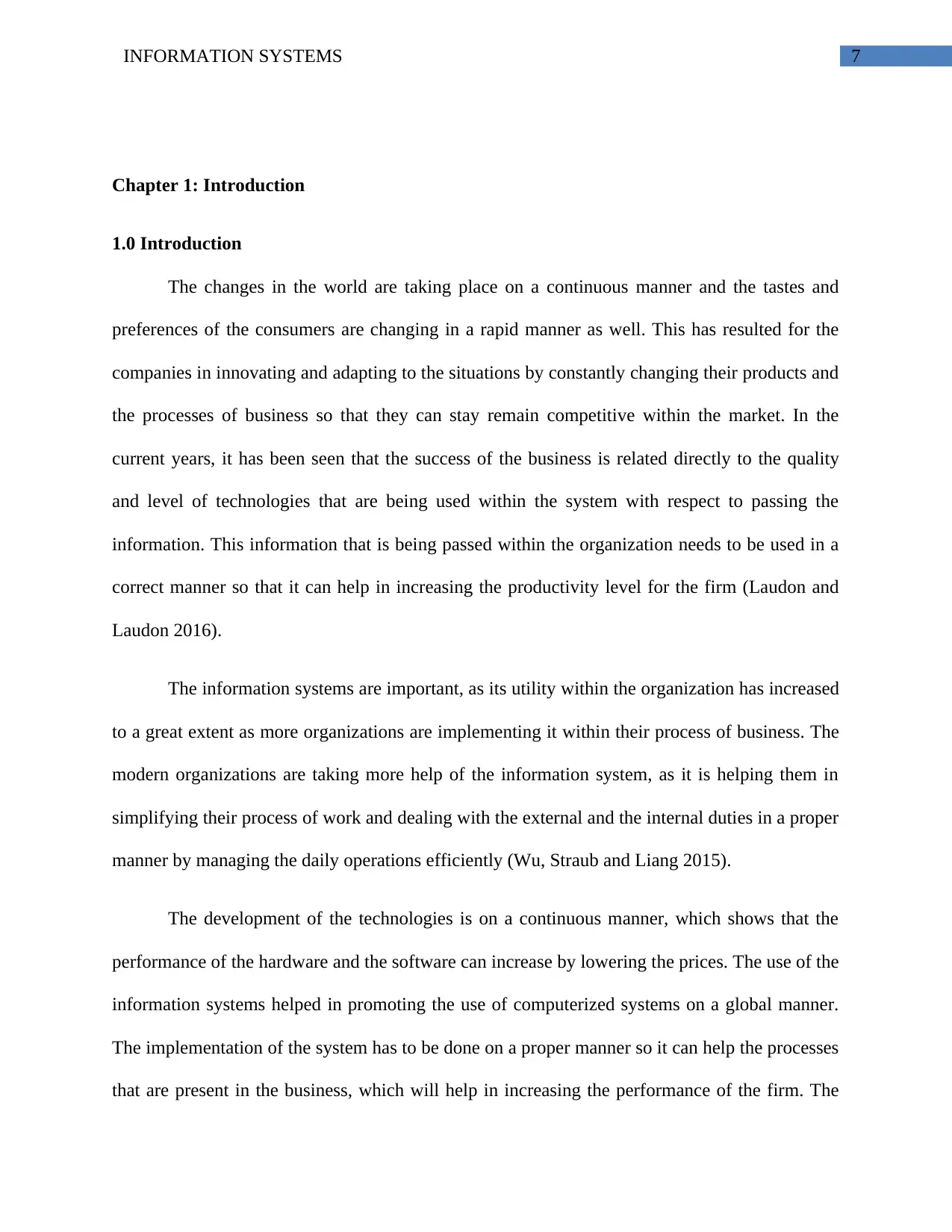
7INFORMATION SYSTEMS
Chapter 1: Introduction
1.0 Introduction
The changes in the world are taking place on a continuous manner and the tastes and
preferences of the consumers are changing in a rapid manner as well. This has resulted for the
companies in innovating and adapting to the situations by constantly changing their products and
the processes of business so that they can stay remain competitive within the market. In the
current years, it has been seen that the success of the business is related directly to the quality
and level of technologies that are being used within the system with respect to passing the
information. This information that is being passed within the organization needs to be used in a
correct manner so that it can help in increasing the productivity level for the firm (Laudon and
Laudon 2016).
The information systems are important, as its utility within the organization has increased
to a great extent as more organizations are implementing it within their process of business. The
modern organizations are taking more help of the information system, as it is helping them in
simplifying their process of work and dealing with the external and the internal duties in a proper
manner by managing the daily operations efficiently (Wu, Straub and Liang 2015).
The development of the technologies is on a continuous manner, which shows that the
performance of the hardware and the software can increase by lowering the prices. The use of the
information systems helped in promoting the use of computerized systems on a global manner.
The implementation of the system has to be done on a proper manner so it can help the processes
that are present in the business, which will help in increasing the performance of the firm. The
Chapter 1: Introduction
1.0 Introduction
The changes in the world are taking place on a continuous manner and the tastes and
preferences of the consumers are changing in a rapid manner as well. This has resulted for the
companies in innovating and adapting to the situations by constantly changing their products and
the processes of business so that they can stay remain competitive within the market. In the
current years, it has been seen that the success of the business is related directly to the quality
and level of technologies that are being used within the system with respect to passing the
information. This information that is being passed within the organization needs to be used in a
correct manner so that it can help in increasing the productivity level for the firm (Laudon and
Laudon 2016).
The information systems are important, as its utility within the organization has increased
to a great extent as more organizations are implementing it within their process of business. The
modern organizations are taking more help of the information system, as it is helping them in
simplifying their process of work and dealing with the external and the internal duties in a proper
manner by managing the daily operations efficiently (Wu, Straub and Liang 2015).
The development of the technologies is on a continuous manner, which shows that the
performance of the hardware and the software can increase by lowering the prices. The use of the
information systems helped in promoting the use of computerized systems on a global manner.
The implementation of the system has to be done on a proper manner so it can help the processes
that are present in the business, which will help in increasing the performance of the firm. The
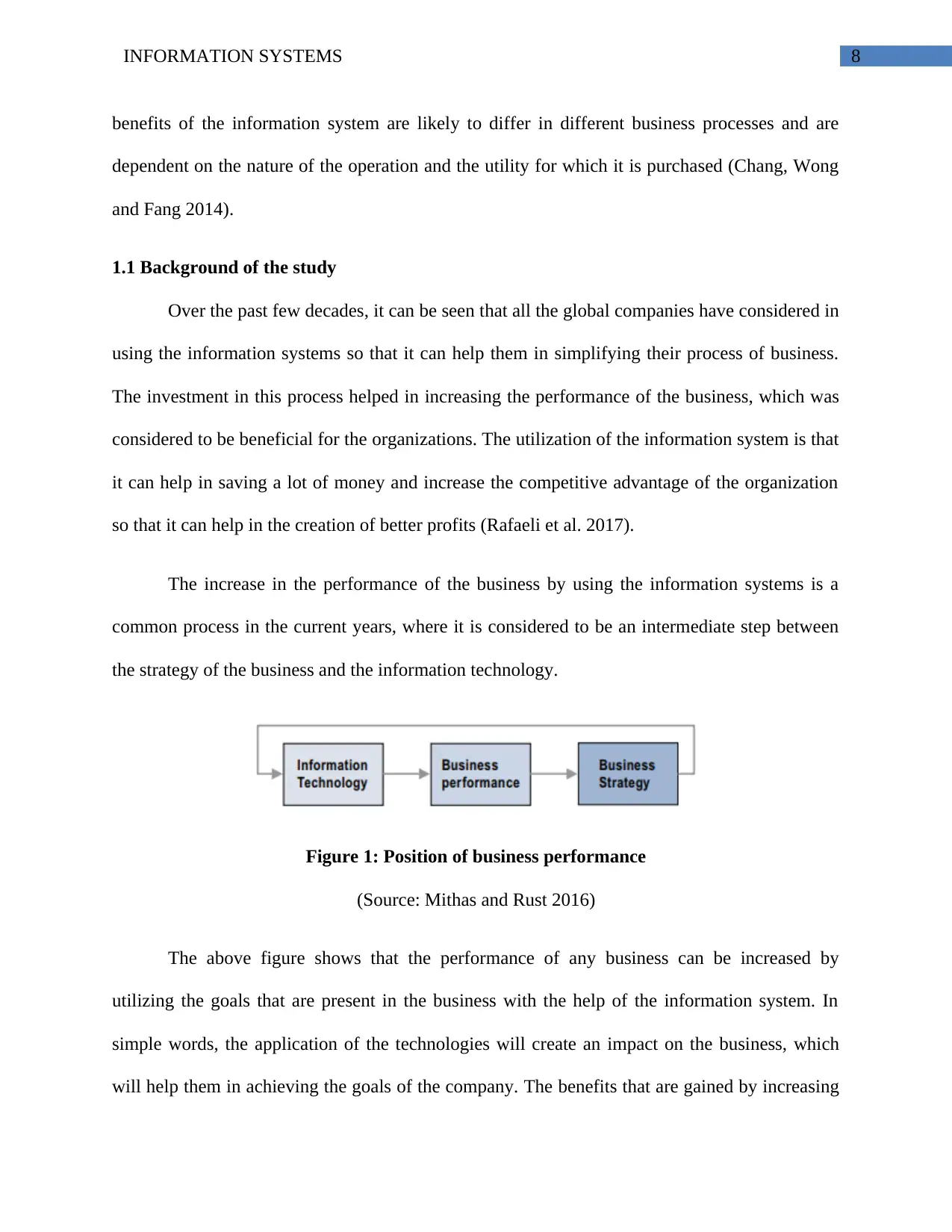
8INFORMATION SYSTEMS
benefits of the information system are likely to differ in different business processes and are
dependent on the nature of the operation and the utility for which it is purchased (Chang, Wong
and Fang 2014).
1.1 Background of the study
Over the past few decades, it can be seen that all the global companies have considered in
using the information systems so that it can help them in simplifying their process of business.
The investment in this process helped in increasing the performance of the business, which was
considered to be beneficial for the organizations. The utilization of the information system is that
it can help in saving a lot of money and increase the competitive advantage of the organization
so that it can help in the creation of better profits (Rafaeli et al. 2017).
The increase in the performance of the business by using the information systems is a
common process in the current years, where it is considered to be an intermediate step between
the strategy of the business and the information technology.
Figure 1: Position of business performance
(Source: Mithas and Rust 2016)
The above figure shows that the performance of any business can be increased by
utilizing the goals that are present in the business with the help of the information system. In
simple words, the application of the technologies will create an impact on the business, which
will help them in achieving the goals of the company. The benefits that are gained by increasing
benefits of the information system are likely to differ in different business processes and are
dependent on the nature of the operation and the utility for which it is purchased (Chang, Wong
and Fang 2014).
1.1 Background of the study
Over the past few decades, it can be seen that all the global companies have considered in
using the information systems so that it can help them in simplifying their process of business.
The investment in this process helped in increasing the performance of the business, which was
considered to be beneficial for the organizations. The utilization of the information system is that
it can help in saving a lot of money and increase the competitive advantage of the organization
so that it can help in the creation of better profits (Rafaeli et al. 2017).
The increase in the performance of the business by using the information systems is a
common process in the current years, where it is considered to be an intermediate step between
the strategy of the business and the information technology.
Figure 1: Position of business performance
(Source: Mithas and Rust 2016)
The above figure shows that the performance of any business can be increased by
utilizing the goals that are present in the business with the help of the information system. In
simple words, the application of the technologies will create an impact on the business, which
will help them in achieving the goals of the company. The benefits that are gained by increasing
⊘ This is a preview!⊘
Do you want full access?
Subscribe today to unlock all pages.

Trusted by 1+ million students worldwide
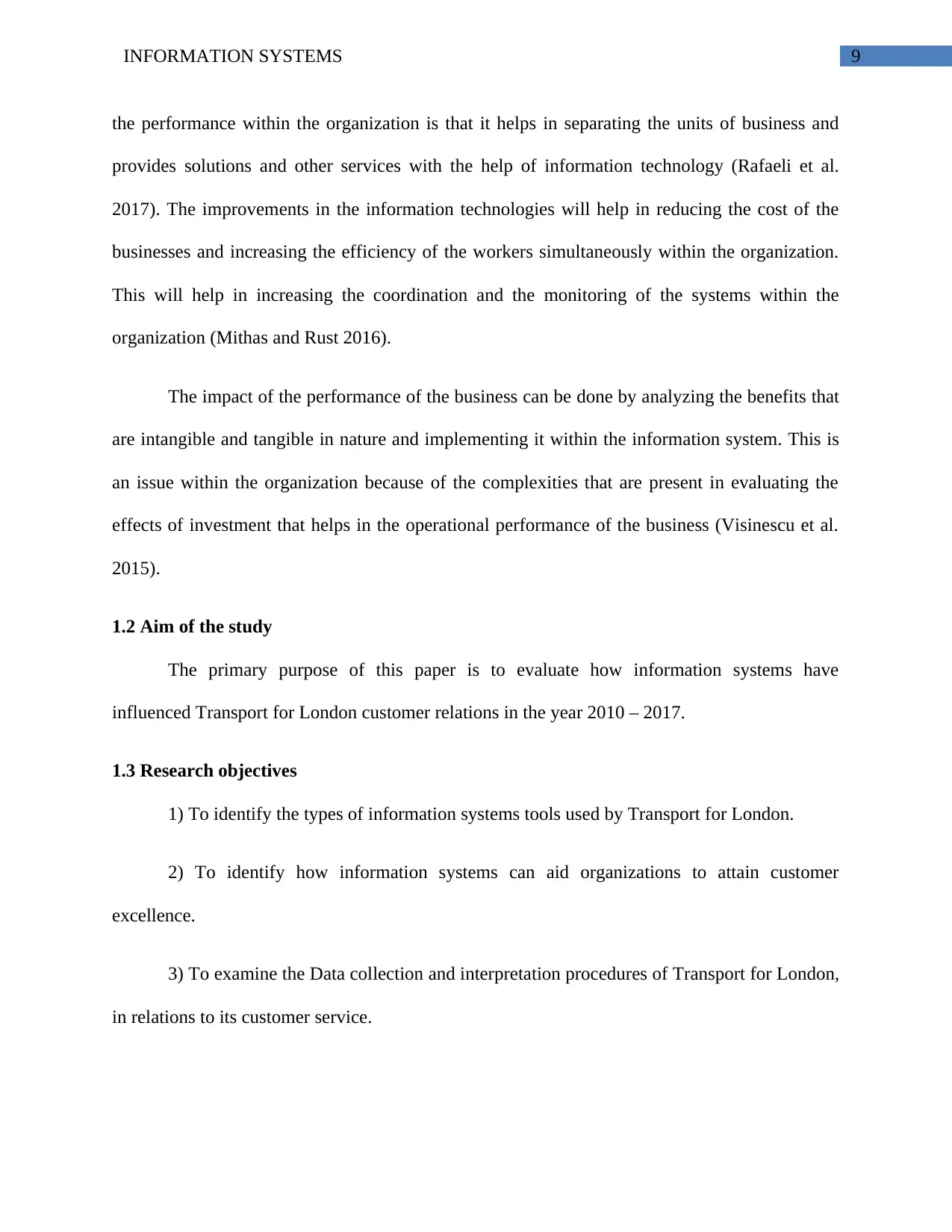
9INFORMATION SYSTEMS
the performance within the organization is that it helps in separating the units of business and
provides solutions and other services with the help of information technology (Rafaeli et al.
2017). The improvements in the information technologies will help in reducing the cost of the
businesses and increasing the efficiency of the workers simultaneously within the organization.
This will help in increasing the coordination and the monitoring of the systems within the
organization (Mithas and Rust 2016).
The impact of the performance of the business can be done by analyzing the benefits that
are intangible and tangible in nature and implementing it within the information system. This is
an issue within the organization because of the complexities that are present in evaluating the
effects of investment that helps in the operational performance of the business (Visinescu et al.
2015).
1.2 Aim of the study
The primary purpose of this paper is to evaluate how information systems have
influenced Transport for London customer relations in the year 2010 – 2017.
1.3 Research objectives
1) To identify the types of information systems tools used by Transport for London.
2) To identify how information systems can aid organizations to attain customer
excellence.
3) To examine the Data collection and interpretation procedures of Transport for London,
in relations to its customer service.
the performance within the organization is that it helps in separating the units of business and
provides solutions and other services with the help of information technology (Rafaeli et al.
2017). The improvements in the information technologies will help in reducing the cost of the
businesses and increasing the efficiency of the workers simultaneously within the organization.
This will help in increasing the coordination and the monitoring of the systems within the
organization (Mithas and Rust 2016).
The impact of the performance of the business can be done by analyzing the benefits that
are intangible and tangible in nature and implementing it within the information system. This is
an issue within the organization because of the complexities that are present in evaluating the
effects of investment that helps in the operational performance of the business (Visinescu et al.
2015).
1.2 Aim of the study
The primary purpose of this paper is to evaluate how information systems have
influenced Transport for London customer relations in the year 2010 – 2017.
1.3 Research objectives
1) To identify the types of information systems tools used by Transport for London.
2) To identify how information systems can aid organizations to attain customer
excellence.
3) To examine the Data collection and interpretation procedures of Transport for London,
in relations to its customer service.
Paraphrase This Document
Need a fresh take? Get an instant paraphrase of this document with our AI Paraphraser

10INFORMATION SYSTEMS
4) To recommend how Transport for London can continually use information systems to
improve its performance.
1.4 Research questions
1) What are the types of information system tools accessible for use in enhancing
customer excellence?
2) What types of information systems tools do Transport for London currently use?
3) How does Transport for London collect, store, and interpret the Big Data to serve its
customers?
4) What is the link between information systems and customer excellence in Transport
for London?
1.5 Research Limitations
The researcher faced many problems while conducting the process of research. The
collection of the data has been secondary in nature, which prevented the researcher from
authenticating the studies that were conducted previously. The economic impact of Transport of
London (TFL) on the United Kingdom has not been taken in to consideration by the researcher.
Moreover, another factor was time that prevented the researcher from analyzing the factors in an
in-depth manner about the topic. The research would have been conducted in a better manner if
the researcher had more time and money so that it could have helped in analyzing the topic in a
better manner.
4) To recommend how Transport for London can continually use information systems to
improve its performance.
1.4 Research questions
1) What are the types of information system tools accessible for use in enhancing
customer excellence?
2) What types of information systems tools do Transport for London currently use?
3) How does Transport for London collect, store, and interpret the Big Data to serve its
customers?
4) What is the link between information systems and customer excellence in Transport
for London?
1.5 Research Limitations
The researcher faced many problems while conducting the process of research. The
collection of the data has been secondary in nature, which prevented the researcher from
authenticating the studies that were conducted previously. The economic impact of Transport of
London (TFL) on the United Kingdom has not been taken in to consideration by the researcher.
Moreover, another factor was time that prevented the researcher from analyzing the factors in an
in-depth manner about the topic. The research would have been conducted in a better manner if
the researcher had more time and money so that it could have helped in analyzing the topic in a
better manner.
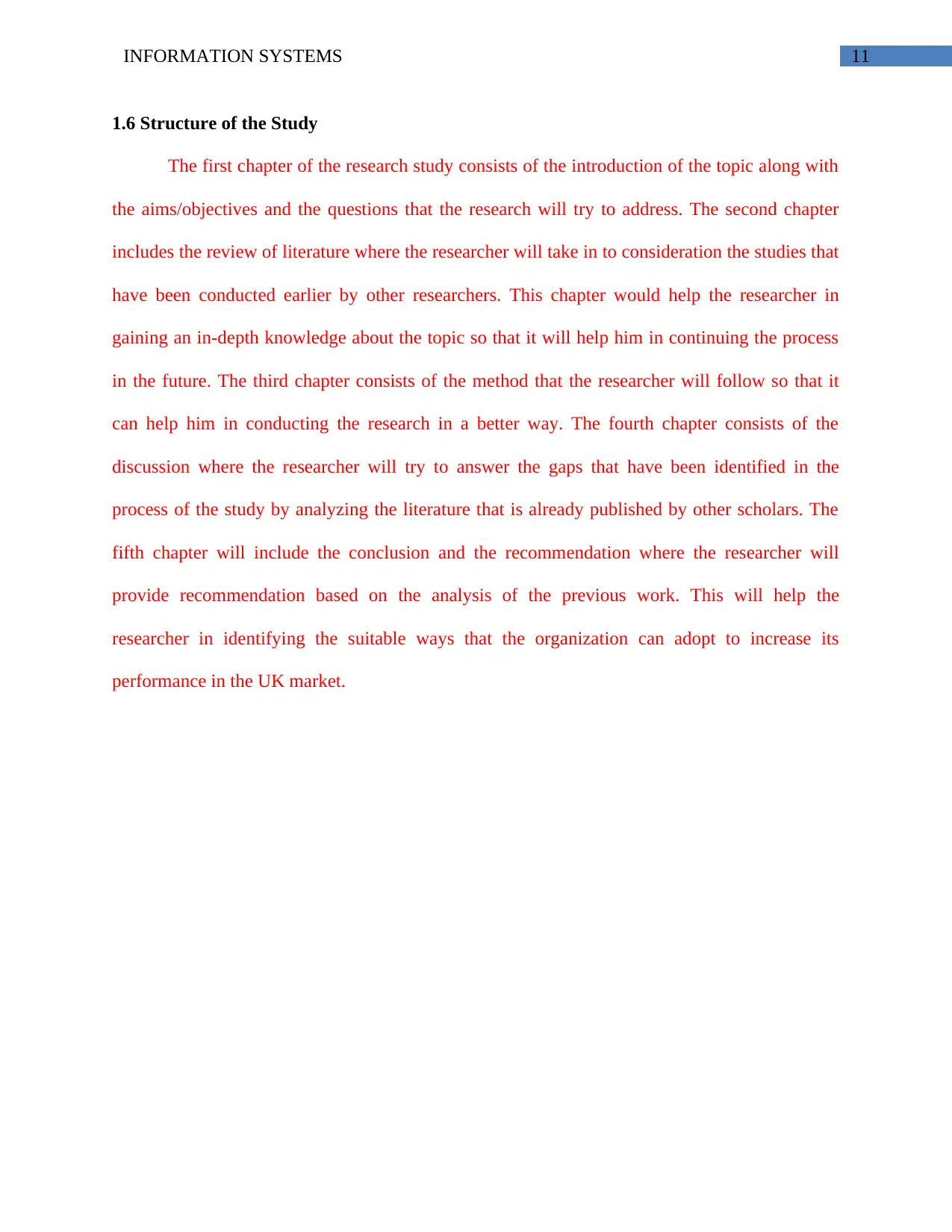
11INFORMATION SYSTEMS
1.6 Structure of the Study
The first chapter of the research study consists of the introduction of the topic along with
the aims/objectives and the questions that the research will try to address. The second chapter
includes the review of literature where the researcher will take in to consideration the studies that
have been conducted earlier by other researchers. This chapter would help the researcher in
gaining an in-depth knowledge about the topic so that it will help him in continuing the process
in the future. The third chapter consists of the method that the researcher will follow so that it
can help him in conducting the research in a better way. The fourth chapter consists of the
discussion where the researcher will try to answer the gaps that have been identified in the
process of the study by analyzing the literature that is already published by other scholars. The
fifth chapter will include the conclusion and the recommendation where the researcher will
provide recommendation based on the analysis of the previous work. This will help the
researcher in identifying the suitable ways that the organization can adopt to increase its
performance in the UK market.
1.6 Structure of the Study
The first chapter of the research study consists of the introduction of the topic along with
the aims/objectives and the questions that the research will try to address. The second chapter
includes the review of literature where the researcher will take in to consideration the studies that
have been conducted earlier by other researchers. This chapter would help the researcher in
gaining an in-depth knowledge about the topic so that it will help him in continuing the process
in the future. The third chapter consists of the method that the researcher will follow so that it
can help him in conducting the research in a better way. The fourth chapter consists of the
discussion where the researcher will try to answer the gaps that have been identified in the
process of the study by analyzing the literature that is already published by other scholars. The
fifth chapter will include the conclusion and the recommendation where the researcher will
provide recommendation based on the analysis of the previous work. This will help the
researcher in identifying the suitable ways that the organization can adopt to increase its
performance in the UK market.
⊘ This is a preview!⊘
Do you want full access?
Subscribe today to unlock all pages.

Trusted by 1+ million students worldwide
1 out of 54
Related Documents
Your All-in-One AI-Powered Toolkit for Academic Success.
+13062052269
info@desklib.com
Available 24*7 on WhatsApp / Email
![[object Object]](/_next/static/media/star-bottom.7253800d.svg)
Unlock your academic potential
Copyright © 2020–2025 A2Z Services. All Rights Reserved. Developed and managed by ZUCOL.





